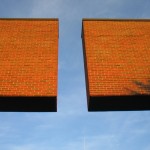 Columbus City Hall
Columbus City Hall
- Built: 1981
- Architect: Edward Charles Bassett / Skidmore, Owings and Merrill (SOM)
After years of trying to adapt to their crowded but historic former home at 5th and Franklin Streets, Columbus entered a bold new bold era in civic affairs in 1981 when the new City Hall opened at the foot of Washington Street. Dramatically angled toward the County Courthouse, this triangular, three-story, 66,000 square foot building contains all city offices as well as the police department. They joined their former neighbor, the Columbus Republic newspaper who had built a building (also designed by SOM) across from the Courthouse a decade earlier.
Architect Edward Charles Bassett of Skidmore, Owings and Merrill (SOM) was selected for the job perhaps partially because he had a common thread of connection to Columbus, what has often been called the “Cranbrook Connection”. Bassett had been in the last graduating class of Eliel Saarinen at the Cranbrook Academy and he worked for a number of years with Eero Saarinen. Over the years in Columbus, many of the architects who were selected for Columbus projects had some type of connection with either the Cranbrook Academy or had worked with one of the Saarinen’s. Eliel Saarinen was head of the architecture department there as well as running his own architecture practice from Cranbrook. Eero Saarinen grew up on the Cranbrook campus (designed by his father) before starting his own architectural firm.
Bassett interviewed local citizens about their favorite buildings downtown and the consensus was that the library and the Courthouse were most admired. Bassett wanted to design a building that would relate well to those as well as to convey the impression that the downtown area started right at the site of City Hall. He wanted to position the police department in such a way that it did not interfere with city government nor intimidate the public but still be on-site and easily accessible. He wanted the building to be friendly and welcoming yet still appear governmental. It needed to be functional as well as flexible to meet changing needs in the future.
He chose a brick color for the upper levels to be complementary to the courthouse while the base exterior level is of Indiana limestone. His right triangle building was angled so that the longest side bisected the full city block site facing the corner of 2nd and Washington and is directly adjacent to the Courthouse. The other two sides are aligned along the adjacent streets for easy parking and access. City offices are on the upper two stories with the police using most of the space on the lower level. He provided direct access and parking for the police department on one of the triangular sides with the other side providing parking and access to the upper two stories for city business. The symbolic main entrance in the front leads directly into the second level and the main city offices. On the northeast corner of the building you will find the engraved inscription “Columbus City Hall”. The style of the letters is copied from an ancient Roman design dating back to 312. As bizarre as it may sound a tiny amount of goat blood was mixed in as coloring in the tradition of this period.
The grand front entrance is meant as a welcoming gesture to residents as well as visitors. The city wanted to portray the impression that city politics were open and transparent to all. The front entrance across the spacious lawn is reached by a series of broad steps. Two steel beams encased in brick veneer are cantilevered across the main entrance framing the courtyard and the two-story semi-circular glass curtain wall which reflects the courthouse across the street and as you personally approach the front door you will see your own reflection in the 26 windows. Each cantilevered beam reaches nearly 39 feet toward the center where they are suspended midair with a highly visible 40 inch gap in the middle. The glass panels are 5 feet wide, more than 21 feet high and weigh 1500 pounds. On the inside narrow glass panels are placed perpendicular to the main windows adding a prismatic perspective.
The entrance opens into a spacious two-story gallery with terrazzo floor and circular staircases on opposite sides. The stairways feature a four-inch bronze handrail and there is a prominent strip of gold leaf trim accenting the gallery area. The galleries provide direct access to most city offices featuring louvered oak doors. There is a large meeting room on the courtyard level that will accommodate up to 200 people. The Council Chamber upstairs will seat about 50 people and features a parquet floor and a recessed ceiling dome.
The front entry way is actually the second floor with the ground level sides containing entrances to the police department and another convenient entrance to the courtyard level from the adjacent side. These side entrances also permit handicap access to all parts of the building. The limestone base on the ground level has been described architecturally as a plinth or palladium basement.
Interior decoration includes many pieces of artwork relating somehow to Columbus, most featuring artists with an Indiana connection. Bassett felt that decorative arts needed to be an integral part of the building as a counterpoint to the architecture. Funds were raised through donations, foundations grants and state and federal arts commissions. Locally the “Hard Hat Ball” was a gala event with food, music and dancing held on 4/10/81 in the still unfinished building to raise funds to purchase artwork for the building. Music was provided by the Jim Edison Orchestra and the Dale Spurlock Quartet. Food was prepared by Max & Cris Lemley and Jim & Claire Gregory.
There is a Robert Indiana painting on one of the main staircases and a William T. Wiley mural on the tympanum of the Council Chambers. Wiley was a native of Bedford, Indiana and Robert Indiana had lived for a period of time in nearby Elizabethtown. Other works include photographs of Columbus buildings by Balthazar Korab, color renderings of downtown storefronts by Alexander Girard and several quilts. The main level meeting room contains a series of paintings commissioned to honor a number of interesting local residents: Carle Miske, Tommy Warner, “Jack the Bum” and Chester Kitzinger.
Original landscaping included Boston Ivy and Climbing Hydrangea on the brick walls, a European Beech and Sugar Maples on the lawn and Little Leaf Linden trees planted to serve as a canopy over the parking lot. Shrubs and hedges are used as well to enhance the architecture. Landscaping is an important part of nearly every Columbus building project; it complements the architecture of the building and adds to the overall urban design. Although the landscaping has changed considerably over the years, it still adds a considerable presence to the building.
Grand opening for the completed $5 million dollar project was Oct 18, 1981. Mayor Nancy Ann Brown, our first female Mayor started out her term in the old building and successfully moved all operations to the new structure. Amazingly enough, the city encountered no debt for the construction although some last minute reductions were made to keep within the budget. Mrs. Brown remembers in particular that the number of lighting fixtures installed was greatly reduced leaving some areas darker than expected which had to be augmented with workstation fixtures. The first city-owned computer was also installed during her one term as Mayor.
As architect Charles Bassett had hoped, the building has aged gracefully as it has been in use for nearly 33 years. It has held up well and from my personal observations functions nicely as a place to conduct our cities business. It is a visually unique structure yet blends in well with the Courthouse, the Republic Newspaper building and the downtown commercial district. The remaining original landscaping has matured nicely but many of the original trees have been replaced.
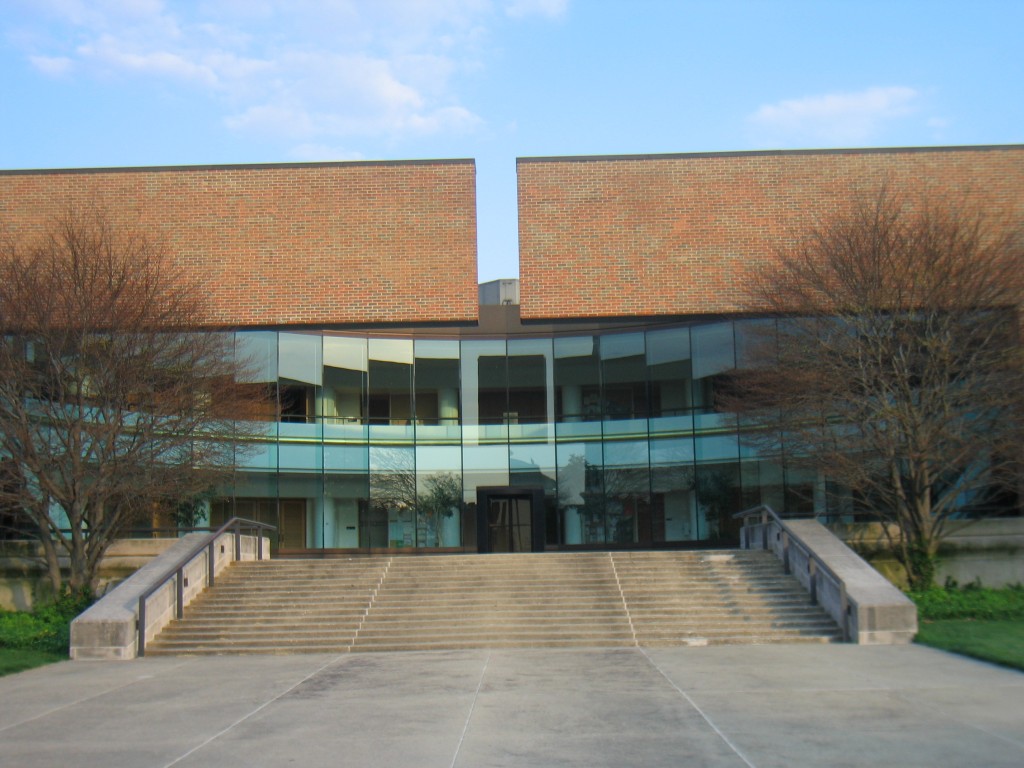 Steps to the front entrance (photo by Ricky Berkey)
Steps to the front entrance (photo by Ricky Berkey)
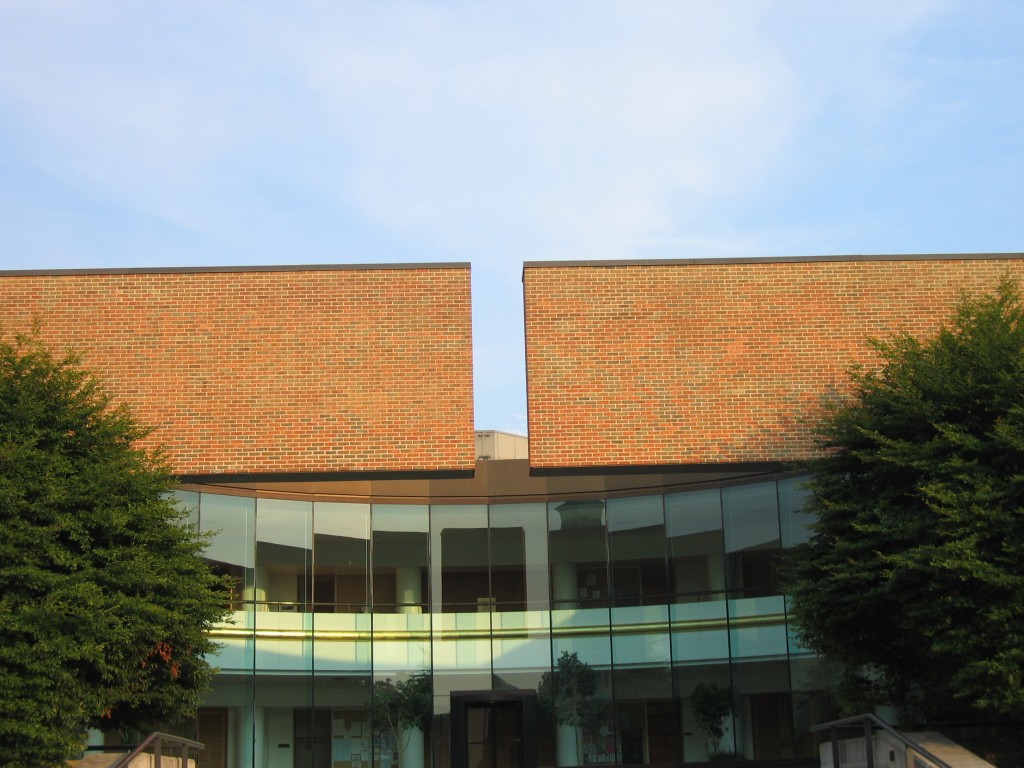 Front Entrance (photo by Ricky Berkey)
Front Entrance (photo by Ricky Berkey)
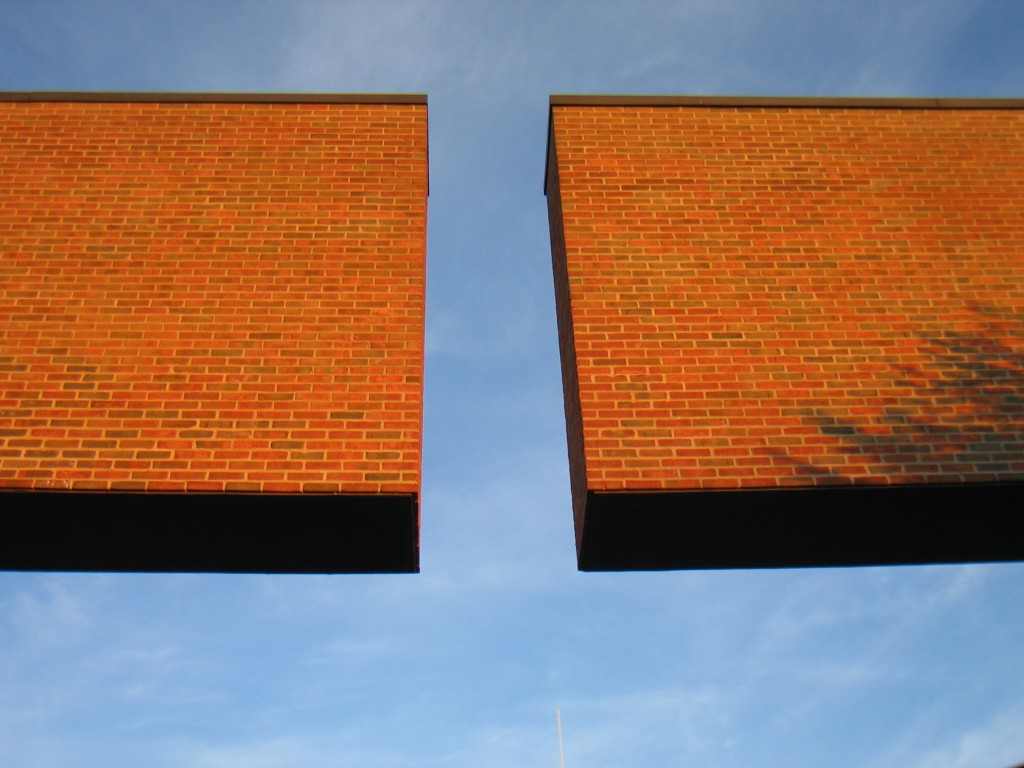 Cantilevered Beams (photo by Ricky Berkey)
Cantilevered Beams (photo by Ricky Berkey)
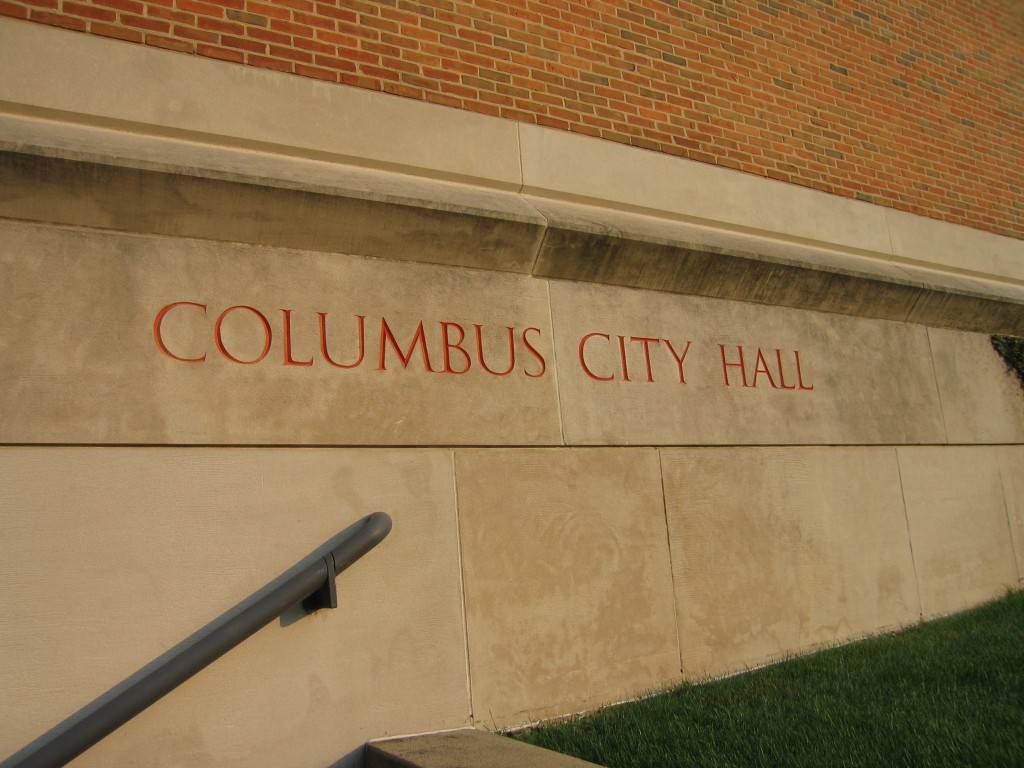 Engraving at NE corner (photo by Ricky Berkey)
Engraving at NE corner (photo by Ricky Berkey)
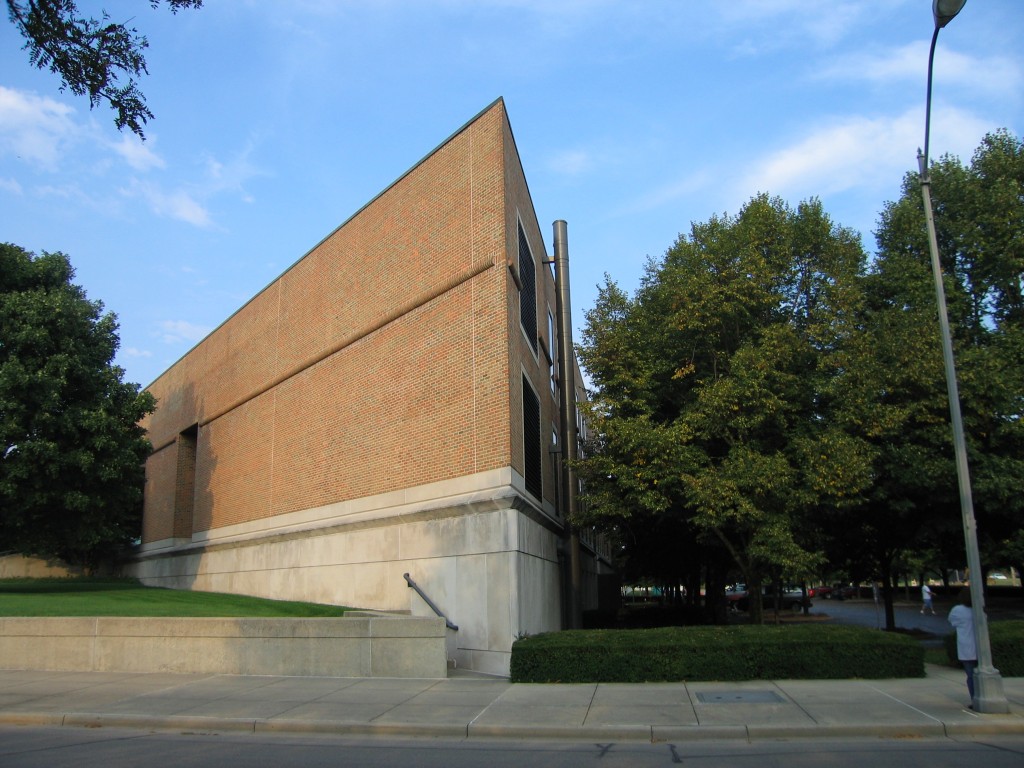 Triangular corner (photo by Ricky Berkey)
Triangular corner (photo by Ricky Berkey)
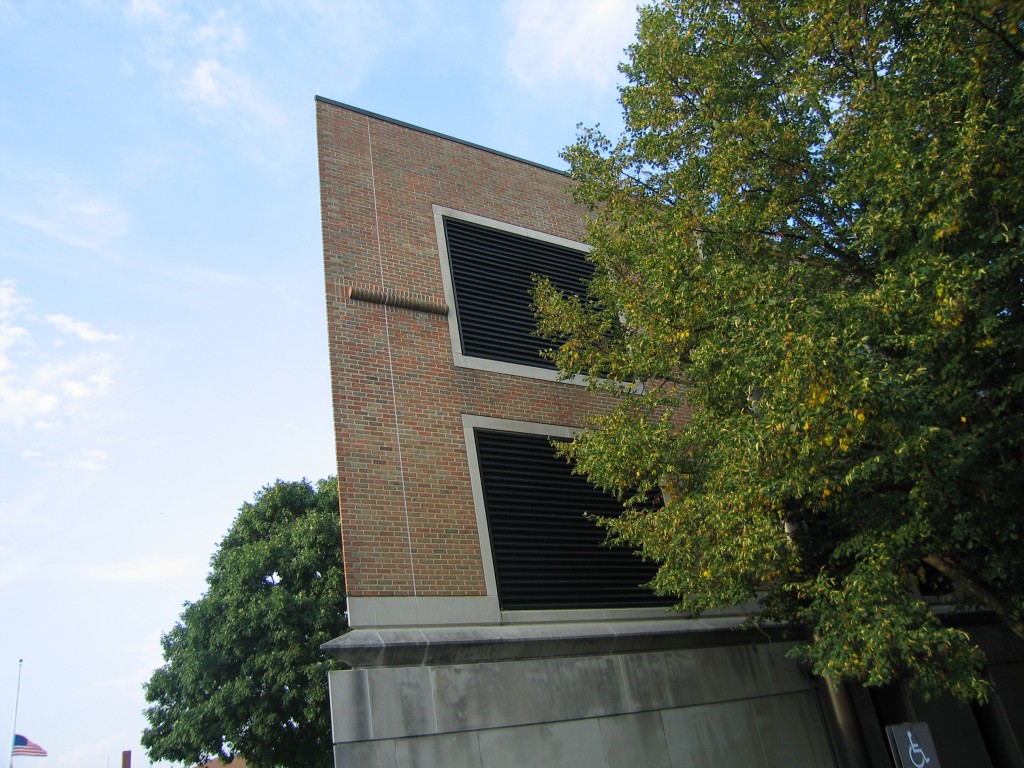 Triangular corner (photo by Ricky Berkey)
Triangular corner (photo by Ricky Berkey)
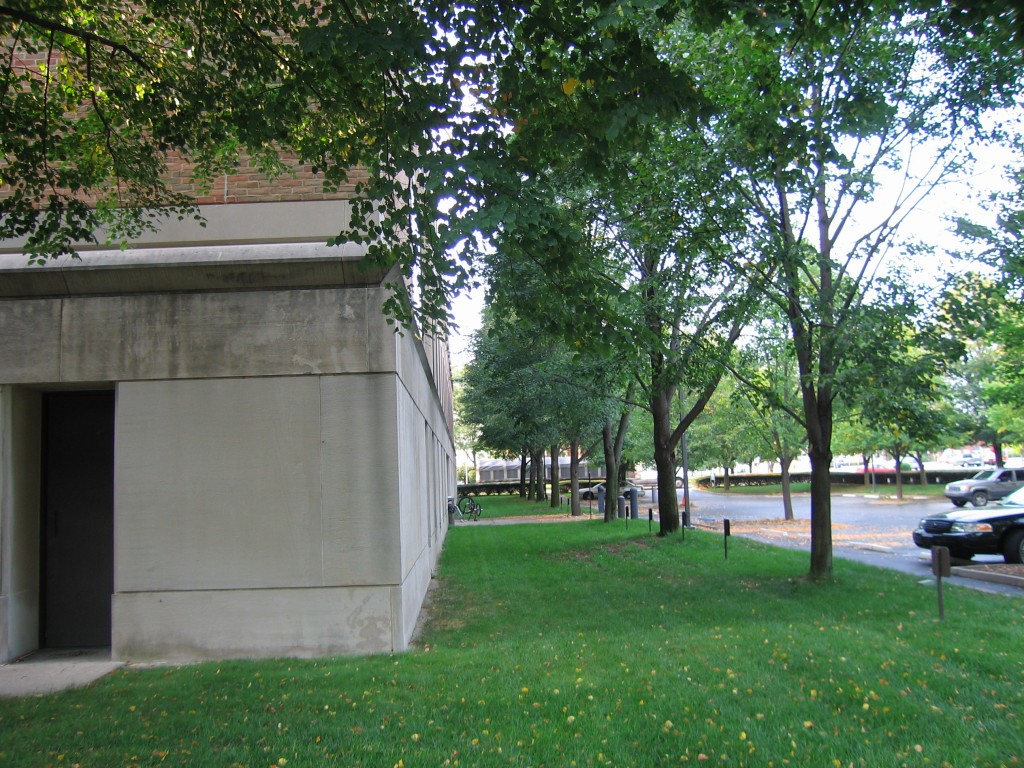 Limestone base at ground level (photo by Ricky Berkey)
Limestone base at ground level (photo by Ricky Berkey)
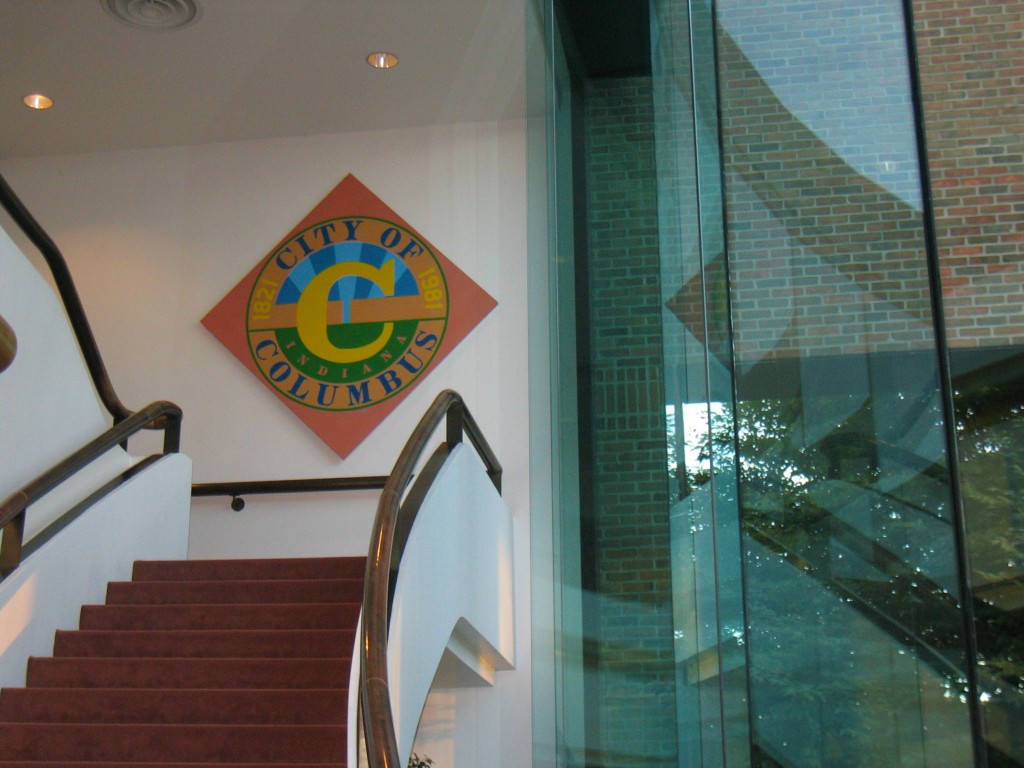 Stairway showing Robert Indiana painting (photo by Ricky Berkey)
Stairway showing Robert Indiana painting (photo by Ricky Berkey)
The Architects
 Edward Charles Bassett
Edward Charles Bassett
- Born: Sept 1921 in Port Huron, Michigan
- Died: 1999 in Mill Valley, California
- University of Michigan, 1949
- Cranbrook Academy, 1951
Edward Charles Bassett commonly referred to as “Chuck” by family and colleagues studied architecture at the University of Michigan before gaining his Master degree from Cranbrook in 1951. He was in the last graduating class of Eliel Saarinen at Cranbrook who had led the architecture department there as well as designing the campus.
Bassett worked with Eero Saarinen before joining the San Francisco office of SOM in 1955 later becoming a general partner in the firm. The Columbus, Indiana City Hall was one of his last projects completed before his retirement in 1981. It was one of the first SOM design projects to break away from the strict Miesian/International Style design that had been so predominant in their folio of projects. One of Bassett’s most famous design projects was the United States Embassy in Moscow which sat unoccupied for over 15 years because of fears that the Russians had embedded espionage devices within that could not be removed.
 Skidmore, Owings and Merrill (SOM)
Skidmore, Owings and Merrill (SOM)
SOM is one of the largest architecture firms in the world combining architecture, engineering and urban design. Because they have numerous talented individual architects under their vast umbrella, SOM can take credit for a large number of the major projects of the 20th Century. Since their founding in Chicago in 1936, they have completed over 10,000 projects in more than 50 countries. It won the AIA Firm of the Year award in both 1961 and 1996, the only firm to be awarded the prize twice. They maintain offices in Chicago, New York, San Francisco, Washington D.C., Los Angeles, London, Hong Kong and Sao Paulo.
Started by Louis Skidmore and Nathaniel Owings in 1936, they were joined by John Merrill in 1939. Their firm stresses teamwork as well as individual responsibility amongst its member architects. They maintain a multi-disciplinary workforce that can design and complete nearly any conceivable project. While many architects have resisted being part of the corporate face of a firm such as SOM, others have appreciated the chance to simply practice their art without having to maintain their own business office. There have been harsh critics of their corporate mentality as well as their faithful adherence for many years to the International/Modernist style of Mies van der Rohe. Frank Lloyd Wright once described Skidmore, Owings and Merrill as “Three Blind Mies”.
Links/References
City of Columbus: official City of Columbus website
Columbus Indiana Architectural Archives
Columbus Indiana Architecture Digital Archives: A small portion of the Columbus Indiana Architectural Archives available online from the IUPUI digital library
3D Models of Columbus Architecture Executed in Google SketchUp:
The Republic Newspaper – Columbus, Indiana newspaper
Bartholomew County Public Library
Historic Columbus Website – David Sechrest’s tribute to Columbus History
Historic Columbus Message Board – a companion interactive forum to the David Sechrest historical website
Bartholomew County Historical Society
 Click HERE for a Calendar of Upcoming Events in the Columbus Area.
Click HERE for a Calendar of Upcoming Events in the Columbus Area.
Click HERE for information about Tours of Columbus Architecture and Design including the Miller House.
 Ricky Berkey
Ricky Berkey
Email me: rickyberkey@gmail.com
